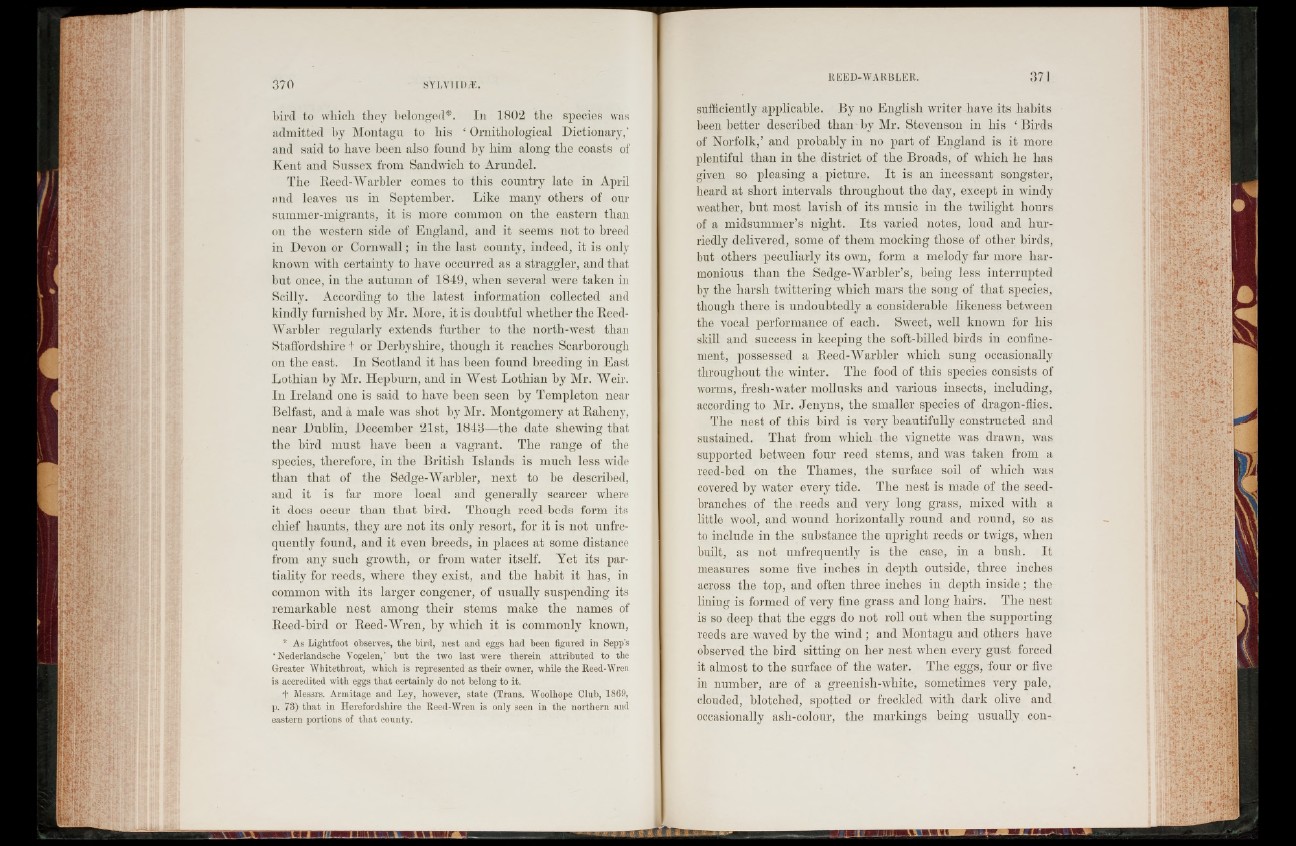
bird, to which they belonged*. In 1802 the species was
admitted by Montagu to his ‘ Ornithological Dictionary,'
and said to have been also found by him along the coasts of
Kent and Sussex from Sandwich to Arundel.
The Reed-Warbler comes to this country late in April
and leaves us in September. Like many others of our
summer-migrants, it is more common on the eastern than
on the western side of England, and it seems not to breed
in Devon or Cornwall; in the last county, indeed, it is only
known with certainty to have occurred as a straggler, and that
but once, in the autumn of 1849, when several were taken in
Scilly. According to the latest information collected and
kindly furnished by Mr. More, it is doubtful whether the Reed-
Warbler regularly extends further to the north-west than
Staffordshire t or Derbyshire, though it reaches Scarborough
on the east. In Scotland it has been found breeding in East
Lothian by Mr. Hepburn, and in West Lothian by Mr. Weir.
In Ireland one is said to have been seen by Templeton near
Belfast, and a male was shot by Mr. Montgomery at Raheny,
near Dublin, December 21st, 1843—the date shewing that
the bird must have been a vagrant. The range of the
species, therefore, in the British Islands is much less wide
than that of the Sedge-Warbler, next to be described,
and it is far more local and generally scarcer where
it does occur than that bird. Though reed-beds form its
chief haunts, they are not its only resort, for it is not unfre-
quently found, and it even breeds, in places at some distance
from any such growth, or from water itself. Yet its partiality
for reeds, where they exist, and the habit it has, in
common with its larger congener, of usually suspending its
remarkable nest among their stems make the names of
Reed-bird or Reed-Wren, by which it is commonly known,
* As Lightfoot observes, the bird, nest and eggs had been figured in Sepp’s
‘ Nederlandsche Vogelen,’ but the two last were therein attributed to the
Greater Whitethroat, which is represented as their owner, while the Reed-Wren
is accredited with eggs that certainly do not belong to it.
+ Messrs. Armitage and Ley, however, state (Trans. Woolhope Club, 1869,
p. 73) that in Herefordshire the Reed-Wren is only seen in the northern and
eastern portions of that county.
sufficiently applicable. By no English writer have its habits
been better described than by Mr. Stevenson in his ‘ Birds
of Norfolk,’ and probably in no part of England is it more
plentiful than in the district of the Broads, of which he has
given so pleasing a picture. I t is an incessant songster,
heard at short intervals throughout the day, except in windy
weather, but most lavish of its music in the twilight hours
of a midsummer’s night. Its varied notes, loud and hurriedly
delivered, some of them mocking those of other birds,
but others peculiarly its own, form a melody far more harmonious
than the Sedge-Warbler’s, being less interrupted
by the harsh twittering which mars the song of that species,
though there is undoubtedly a considerable likeness between
the vocal performance of each. Sweet, well known for his
skill and success in keeping the soft-billed birds in confinement,
possessed a Reed-Warbler which sung occasionally
throughout the winter. The food of this species consists of
worms, fresli-water mollusks and various insects, including,
according to Mr. Jenyns, the smaller species of dragon-flies.
The nest of this bird is very beautifully constructed and
sustained. That from which the vignette was drawn, was
supported between four reed stems, and was taken from a
reed-bed on the Thames, the surface soil of which was
covered by water every tide. The nest is made of the seed-
branches of the reeds and very long grass, mixed with a
little wool, and wound horizontally round and round, so as
to include in the substance the upright reeds or twigs, when
built, as not unfrequently is the case, in a bush. It
measures some five inches in depth outside, three inches
across the top, and often three inches in depth inside; the
lining is formed of very fine grass and long hairs. The nest
is so deep that the eggs do not roll out when the supporting
reeds are waved by the wind; and Montagu and others have
observed the bird sitting on her nest when every gust forced
it almost to the surface of the water. The eggs, four or five
in number, are of a greenish-white, sometimes very pale,
clouded, blotched, spotted or freckled with dark olive and
occasionally ash-colour, the markings being usually con